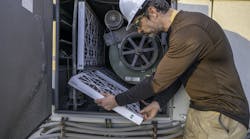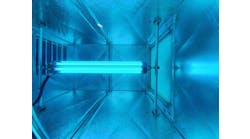In July 2023, as smoke from Canadian wildfires swept across the Northeast United States, bringing unprecedented bad air quality and turning the skies an eerie shade of orange, New York City officials announced that they would propose a new batch of new indoor air quality regulations—the first of their kind in decades. The two bills, which would require the city to establish standards for measuring, monitoring, reporting, and enforcing air quality inside schools and municipal buildings, had at their time of announcement been under development for more than a year. The intolerable reality of wildfire smoke brought renewed interest to desperately needed IAQ action.
The city’s move highlights an important consideration in indoor air quality (IAQ) management—namely, that despite COVID-19’s transition from pandemic to endemic, controlling IAQ remains an urgent issue. In fact, indoor settings are subject to range of internal contaminants, including but not limited to:
- Airborne viruses and bacteria
- Nitrogen dioxide, formaldehyde, carbon monoxide and other pollutants
- Dust mites, pollen and other allergens
- Molds
New York City is among a wave of entities, public and private, that are recognizing the importance of IAQ. In March 2022, the Biden administration released its Clean Air in Buildings Challenge, developed in collaboration with federal agencies including the Environmental Protection Agency, Centers for Disease Control and Prevention and Department of Energy. The challenge offers recommendations and resources for improving ventilation and IAQ and was accompanied by billions of dollars in the American Rescue Plan set aside for improving ventilation in schools and government buildings.
The CDC is also signaling a renewed focus on IAQ. In May, the centers updated their recommendations regarding “Ventilation in Buildings,” which outlines steps to improving air circulation and cleanliness.
The most impactful action so far, however, may turn out to be the publication of the American Society of Heating, Refrigerating, and Air-Conditioning Engineers’ new airborne risk mitigation standard, Standard 241. The ASHRAE standard, published in June, establishes minimum requirements for limiting building occupants’ risk of exposure to infectious aerosols in new and existing buildings. While the standard does not have regulatory powers in itself, ASHRAE standards are often referenced in local building codes. They’re also commonly used by consulting engineers, mechanical contractors, architects, and government agencies.
Aspects of Standard 241 relevant to the management and ownership of facilities include:
- Infection risk management mode: The standard establishes requirements for a building’s infection risk management mode (IRMM). This mode is to be applied during identified periods of elevated disease transmission. It requires buildings to be able to respond to extreme circumstances far beyond normal conditions in indoor air quality.
- Equivalent clean air flow rate: Standard 241 includes minimum requirements for equivalent clean airflow rate per occupant of pathogen-free air flow.
- Filtration and air cleaning technology: Guidance for how to use filtration and air cleaning technology like HEPA filters, air ionizers, or UV lights to achieve equivalent clean airflow requirements safely and cost effectively are included.
- Planning and commissioning: The standard includes assessment and planning requirements to ensure readiness for pandemic events. It also includes a building readiness plan that documents procedures for assessing existing or new HVAC systems to determine they’re meeting equivalent clean air flow rates.
Together, these actions from legislators, government agencies and industry signal the beginning of a wave sweeping through U.S. buildings and the antiquated IAQ standards that currently regulate them. To remain in compliance and protect their occupants, facilities managers will need to ride this wave with poise and precision. And to do that, they’ll need to become hyper-familiar with air filtration and cleaning technology.
To that end, here’s a crash course in what to look out for when evaluating air filtration devices for a space.
Air Changes Per Hour (ACH)
IAQ is commonly measured in terms of air changes per hour (ACH). An ACH measurement represents the number of times per hour the air in the room is completely replaced with fresh air.
How many air changes per hour is enough? As a benchmark, the CDC recommends an ACH rate of at least 5. However, many indoor spaces can’t reach this rate through window or HVAC ventilation alone. In fact, many HVAC systems can only sustain a modest 2 or 3 ACH, regardless of what kind of filter they’re fitted with. In these cases, a filtration device is required.
To determine how much additional air changes per hour a filtration device can add, simply multiply the airflow in cubic feet per minute (CFM) of the filter (find this number in the device’s specs) by 60 (the number of minutes in an hour), then divide the result by the volume of the room.
Minimum Efficiency Reporting Value (MERV) and High Efficiency Particulate Air (HEPA) Filters
To provide fresh air to a space, the air filtration device must actually be effective at cleaning air. Pre-COVID, MERV 11 or MERV 8 filters were standard, offering suboptimal defense against airborne contaminants. (MERV standards for “minimum efficiency reporting value,” a rating of how effective a filter removes particles from the air passing through it. The higher the number, the more particles it captures.) At the start of the pandemic, experts and authorities began to recommend installing MERV 13 filters. The inclusion of MERV 13 filters or higher, however, pressures most systems, jeopardizing their efficiency and imperiling indoor air quality.
Today’s IAQ recommendations go even further, almost always calling for HEPA filters. HEPA stands for “high efficiency particulate air [filter].” Designed to capture nearly 100% of viral particles, all HEPA filters have a MERV rating of at least 17 and are proven to be able to continuously remove COVID-19 from the air. HEPA filters outperform MERV 13 filters—which capture only around 50% of viral loads—by a significant margin. However, because HEPA filters are so fine, they cannot be fitted to most existing HVAC systems. In most cases, the only way to add one to a facility is with a standalone HEPA filtration device.
Power Consumption, Sound Level and Other Considerations
The CFM and the MERV rating, while critical, aren’t the only considerations when it comes to air filters.
- The energy consumption of an air filtration device that’s active 24/7/365 isn’t inconsiderable. Some models offer features like operation scheduling and proximity sensors, allowing you to keep the filters idle until they’re needed.
- Sound level is another oft-overlooked factor when comparing air filters. A noisy device can be distracting or even downright annoying, which may encourage occupants to look for ways to defeat the device. To avoid scenarios like these, air filtration devices should be evaluated for their decibel level as well.
- Lastly, form factor is not something to be underestimated. A built-in unit is more stylish and tamper-proof, though (obviously) less portable than a traditional free-standing machine.
Ceiling-mounted air purifiers are an increasingly popular choice for facilities managers, as they strike an ideal balance between performance, noise and form factor. Strategically positioned to optimize air circulation and purification, ceiling purifiers maintain a discreet profile. With models on the market offering noise levels of 50dB or less, they also conform to the maximum tolerable noise level for spaces with occupants.
Of paramount importance, these ceiling units are scalable to achieve the requisite 5 ACH, providing an ongoing cycle of air purification. The combination of HEPA filters and the strategic placement on ceilings addresses viral load concerns while proficiently capturing particulate matter that exacerbates allergies and asthma. The outcome is an environment where occupants respire with ease and relish in optimal air quality.
Looking Forward
There’s no question that the indoor air quality revolution is here, with city officials, industry regulators and even the president of the United States pounding the drums. That it took a global pandemic to spur on this much-needed change is truly a tragedy. But with any luck, the IAQ revolution of our age will be discussed in the classrooms of the future as a major tipping point in the history of public health.


